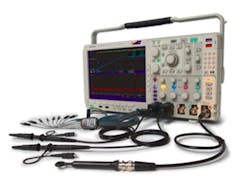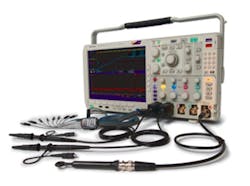Do you remember when an engineer was either a mixed-signal/digital engineer or an RF engineer? That was before wireless, a ubiquitous and sometimes complex technology. As a result, many design engineers today find themselves working in both the time and frequency domains.
To address this challenge, Tektronix developed the world’s first mixed-domain oscilloscopes (MDOs). The new MDO4000 Series combines the functionality of a scope and a spectrum analyzer to capture time-correlated analog, digital, and RF signals. Essentially, MDOs break down the barrier between the domains when debugging designs, allowing you to simultaneously see multiple aspects of a system’s operation.
The MDO4000, the result of many years of R&D, acquires and displays the signals across one RF, four analog, and 16 digital channels. The RF input frequency range extends to 6 GHz and provides a capture bandwidth of ³1 GHz at all center frequencies. You also can view as many as four decoded serial and parallel buses at one time on the same display. And all of this technology is housed in a small form factor measuring 5.8 inches deep x 9 inches high.
As a result of the time correlation between domains, accurate timing measurements can be collected to help understand delays and latencies between command/control events in the design and corresponding changes in the RF spectrum. In addition, the time-correlated system view across both domains more quickly pinpoints the source of intermittent EMI.
The MDO4000 allows you to see the RF spectrum of a signal at any point within a long acquisition. By moving the patent-pending Spectrum Time window through the time-domain acquisition, you simultaneously study both the RF spectrum and the analog, digital, and decoded buses.
RF time-domain traces shown in the same window as the analog, digital, and serial/parallel bus decoded waveforms illustrate how the amplitude, frequency, or phase of the RF input signal changes relative to time. This capability helps characterize frequency hop transitions, settling times, and RF event timing relative to other system components and activities.
An optional module allows additional trigger types to use the RF power level as a source, further isolating an RF event of interest. You can trigger on a specific pulse width, look for a timeout event or runt, or include the RF input in a logic pattern defined along with the analog and digital channels.
The MDO4000 also incorporates tools found in Tek’s MSO4000B Mixed-Signal Oscilloscope Series. These include features that facilitate the design debugging process and range from discovering an anomaly and capturing it to searching waveform records for the event and analyzing its characteristics and the device’s behavior.
Application Examples
To appreciate the many capabilities of the new MDOs, it is helpful to look at some of the application areas they can address. For system-level debug of wireless-enabled designs, the scope/spectrum analyzer combination provides integrated debugging of common wireless modules below 6 GHz such as WLAN, Bluetooth, and Zigbee; debugging of common amplitude-, frequency-, or phase-modulated wireless communications; and wideband analysis of dual-band transceivers, such as capturing Zigbee at 900 MHz and Bluetooth at 2.4 GHz in a single acquisition.
When timing analysis for mixed-domain designs is the focus, the MDO4000s can observe spectrum changes over time during turn-on of VCO/PLLs, measure time to stability when turning RF signals on or off, and determine latencies from control logic signals or serial bus commands to resultant RF changes. As an instrument for tracking down sources of noise or interference, the MDOs analyze the cause of radiated or coupled emissions, measure switch-mode power supply effects on the rest of the system, and examine spurious noise sources in correlation with time-domain signals.

